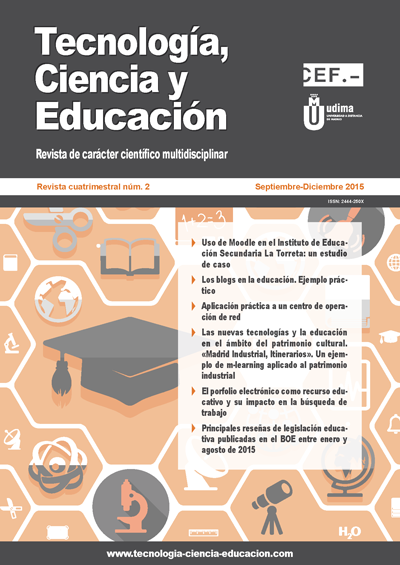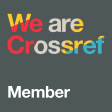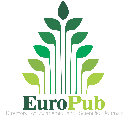New technologies and education in the field of cultural heritage. «Madrid Industrial, Itineraries». An example of m-learning applied to industrial heritage
DOI:
https://doi.org/10.51302/tce.2015.52Keywords:
information society, knowledge society, information and comunication technologies (ICT), m-learning, smartphones, app, industrial heritageAbstract
The development of the information and communication technologies (ICT), integrated within the current knowledge society, has transformed the way in which the human being relates to its environment. The integration of internet on mobile devices is one of the most representative cases on this matter. The universalization of smartphones has allowed not only to amplify the interpersonal communication but also explore new scenarios previously unsuspected. The application of mobile technologies to the education, which has been defined as m-learning, is breaking schemes of the traditional binominio teaching and learning to articulate pillar more dynamic as immediate access to knowledge, collaborative work or personalized learning. As a result of the numerous m-learning applications, it was considered appropriate to focus this research in the field of heritage education. That’s why an application (app) for mobile that allows to interpret a cultural itinerary articulated in the industrial heritage of Madrid has been designed. The objective of this study consists of analysing how changes the app user’s perception of the industrial heritage after finishing the route in order to get results that allow design educational projects of and implement more effective cultural policies.
Downloads
References
Amer, H. y Ibrahim, W. [2014]: «Using the iPad as a pedagogical tool to enhance the learning experience for novice programming students», Global Engineering Education Conference (EDUCON), págs. 178-183.
Brazuelo, F. y Gallego, D. [2011]: Mobile learning. Los dispositivos móviles como recurso educativo, Sevilla, Eduforma.
Credé, A. y Mansell, R. [1998]: Knowledges societies. Information technologies for susteinable development, Otawa: International Development Center.
Crovi, D. [2002]: «Sociedad de la información y el conocimiento», Entre el optimismo y la desesperanza, Revista Mexicana de Ciencias Sociales y Políticas, año XLV, núm. 185, mayo-agosto, págs. 13-34.
De la Peña, F. D. y Prieto, S. [2014]: «Experiencia de aprendizaje mediante aplicación móvil en la enseñanza a distancia: un enfoque para la asignatura de Grado –Dirección de la Producción– utilizando Android», VII Congreso Internacional Ikasnabar 2014. Microcontents, miniMOOCs and mLearning, Bilbao.
Drucker, P. [1969]: «La era de la discontinuidad», Información Comercial Española, núm. 431, págs. 15-34.
Gikas, J. y Grant, M. [2013]: «Mobile computing devices in higher education: student perspectives on learning with cellphones, smartphones & social media», The Internet and Higher Education, págs. 1-9. Disponible en: http://www.trea.es/material/descargas/Hermus%2013%20web.pdf [Consulta: 23 de marzo de 2014].
Gómez, L. y Hidalgo, C. [2014]: «El impacto en la legislación española de la evolución internacional del concepto de “patrimonio industrial”. Un análisis mediante variables», Patrimonio Cultural y Derecho, Fundación AENA y Asociación Hispania Nostra, núm. 18.
Hargis, J.; Cavanaugh, C.; Kamali, T. y Soto, M. [2014]: «A federal higher education iPad mobile learning initiative: triangulation of data to determine early effectiveness», Innovative Higher Education, 39 (1), págs. 45-57.
Hernández, F. X.; Martínez, T. y Rojo, M. C. [2010]: «Los límites de la interactividad», en J. Santacana y C. Martín (eds.), Manual de museografía interactiva, Gijón, Editorial Trea, págs. 575-611.
Hidalgo, C. y Palacios, A. [2015]: «El patrimonio industrial declarado bien de interés cultural en Madrid. Su integración en la oferta cultural y turística de la ciudad», Pasos. Revista de Turismo y Patrimonio Cultural, 14 (en prensa).
Imbert-Bouchard, D.; Llonch, N.; Martín. C. y Osácar, E. [2013]: «Cultural tourism & Apps. A brief overview of the current situation», Her&Mus. Heritage & Museography, 5 (2), págs. 44-54. Disponible en: http://www.trea.es/material/descargas/Hermus%2013%20web.pdf [Consulta: 23 de marzo de 2014].
Isabwe, G. M. N.; Reichert, F. y Carlsen, M. [2013]: «Rethinking practices of assessment for learning: tablet technology supported assessment for learning mathematics», Teaching, Assessment and Learning for Engineering (TALE), 2013 IEEE International Conference, págs. 155-159.
López, V. [2014]: «M-learning, ¿la nueva forma de aprendizaje del siglo XXI?», en J. Santacana y L. Coma (coords.), El m-learning y la educación patrimonial, Gijón, Ediciones Trea, págs. 47-60.
López i Amat [2010]: De la sociedad de la información a la(s) sociedad(es) del conocimiento. Vasos comunicantes en el cambio de milenio. 1960-2010. Trabajo de Investigación DEA, Departamento de Historia de Comunicación Social, Universidad Complutense de Madrid. Disponible en: https://archive.org/details/SociedadInformacion-SociedadConocimiento [Consulta: 23 de marzo de 2014].
Martínez, T. y López, V. [2014]: «La tecnología móvil: de medio de comunicación a instrumento educativo y de inclusión», en J. Santacana y V. López (coords.), Educación, tecnología digital y patrimonio cultural. Para una educación inclusiva, Gijón, Ediciones Trea, págs. 39-46.
Martínez, T. y Santacana, J. [2014]: «Modelos de educación patrimonial basados en telefonía móvil. El patrimonio cultural», en J. Santacana y L. Coma (coords.), El m-learning y la educación patrimonial, Gijón, Ediciones Trea, págs. 75-108.
Masudo, Y. [1984]: La sociedad informatizada como sociedad post-industrial, Madrid, Tecnos.
Oberer, B. y Erkollar, A. [2013]: «Mobile learning in higher education: a marketing course design project in Austria», Procedia-Social and Behavioral Sciences, 93, págs. 2.125-2.129.
Ozuorcun, N. C. y Tabak, F. [2012]: «Is m-learning versus e-learning or are they supporting each other», Procedia Social and Science Behaviour, 46, págs. 294-305. Disponible en: http://www.sciencedirect.com/science/article/pii/S1877042812012396 [Consulta: 23 de marzo de 2014].
Pardo, C. [2004]: Vaciado industrial y nuevo paisaje urbano en Madrid. Antiguas fábricas y renovación de la ciudad, Madrid, Ediciones La Librería.
Revilla, F. y Ramos, R. [2008]: La arquitectura industrial de Madrid, Madrid, Editorial La Librería.
Santacana, J. y Martínez, T. [2014]: «Cerebro, inteligencia, educación y Revolución Industrial», en J. Santacana y V. López (coords.), Educación, tecnología digital y patrimonio cultural. Para una educación inclusiva, Gijón, Ediciones Trea, págs. 47-52.
Sarrab, M.; Elgamel, L. y Aldabbas, H. [2012]: «Mobile Learning (m-learning) and educational environments», International Journal of Distributed and Parallel Systems, 3 (4), págs. 28-31. Disponible en: http://www.academia.edu/1884975/Mobile_Learning_M-Learning_and_Educational_Environments [Consulta: 23 de marzo de 2014].
TICCICH e ICOMOS [2003]: Carta de Nizhy Tagil sobre Patrimonio Industrial [Consulta: 23 de marzo de 2014].
Vacas, F. [2014]: La nueva normalidad: evolución tecnológica, comunicación y empleo, Madrid, CEF.
Vilar, P. [1969]: Oro y moneda en la historia. 1420- 1920, Barcelona, Ariel.
Informes, normativas y planes consultados:
Global Digital Statistics [2014]: realizado por la compañía We Are Social. Disponible en: http://wearesocial.net/tag/sdmw/ [Consulta: 23 de marzo de 2014].
Informe KPCB Internet Trends 2014 from Kleiner Perkins Caufield & Byers. Disponible en: http://www.kpcb.com/blog/tag/Internet%20Trends [Consulta: 23 de marzo de 2014].
Instituto de Patrimonio Cultural Español [2011]: Revisión del Plan Nacional de Patrimonio Industrial. Disponible en: http://ipce.mcu.es/pdfs/PN_PATRIMONIO_INDUSTRIAL.pdf [Consulta: 23 de marzo de 2014].
Instituto de Patrimonio Histórico Español [2014]: Plan Nacional de Educación y Patrimonio. Disponible en: http://ipce.mcu.es/pdfs/PNEducPatrimonio.pdf [Consulta: 23 de marzo de 2014].
IPHE [2007]: «Plan Nacional de Patrimonio Industrial», Revista del Instituto de Patrimonio Histórico Español, núm. 7.
Ley 10/1998, de 9 de julio, de Patrimonio Histórico de la Comunidad de Madrid.
TICCIH e ICOMOS [2003]: Carta de Nizhnt Tagil.
V Estudio Anual IAB Spain Mobile Marketing [2014]: Disponible en: http://www.iabspain.net/mobile-marketing/ [Consulta: 23 de marzo de 2014].
Downloads
Published
How to Cite
Issue
Section
License
Copyright (c) 2015 Francisco David de la Peña Esteban, Carmen Hidalgo Giralt, Antonio J. Palacios García

This work is licensed under a Creative Commons Attribution-NonCommercial-NoDerivatives 4.0 International License.


























